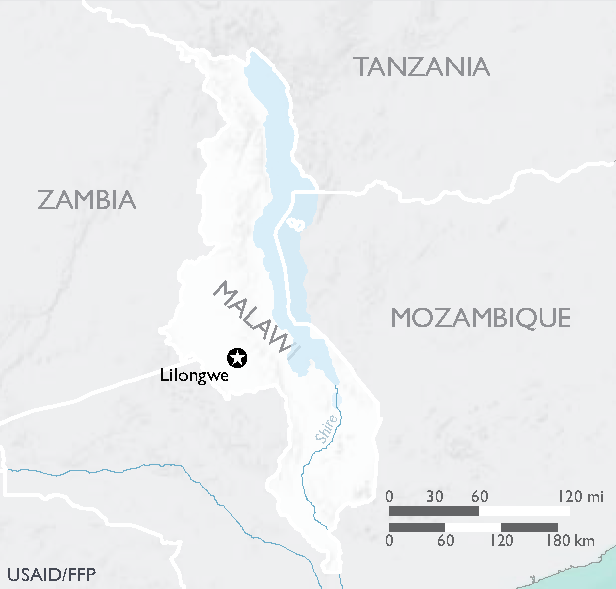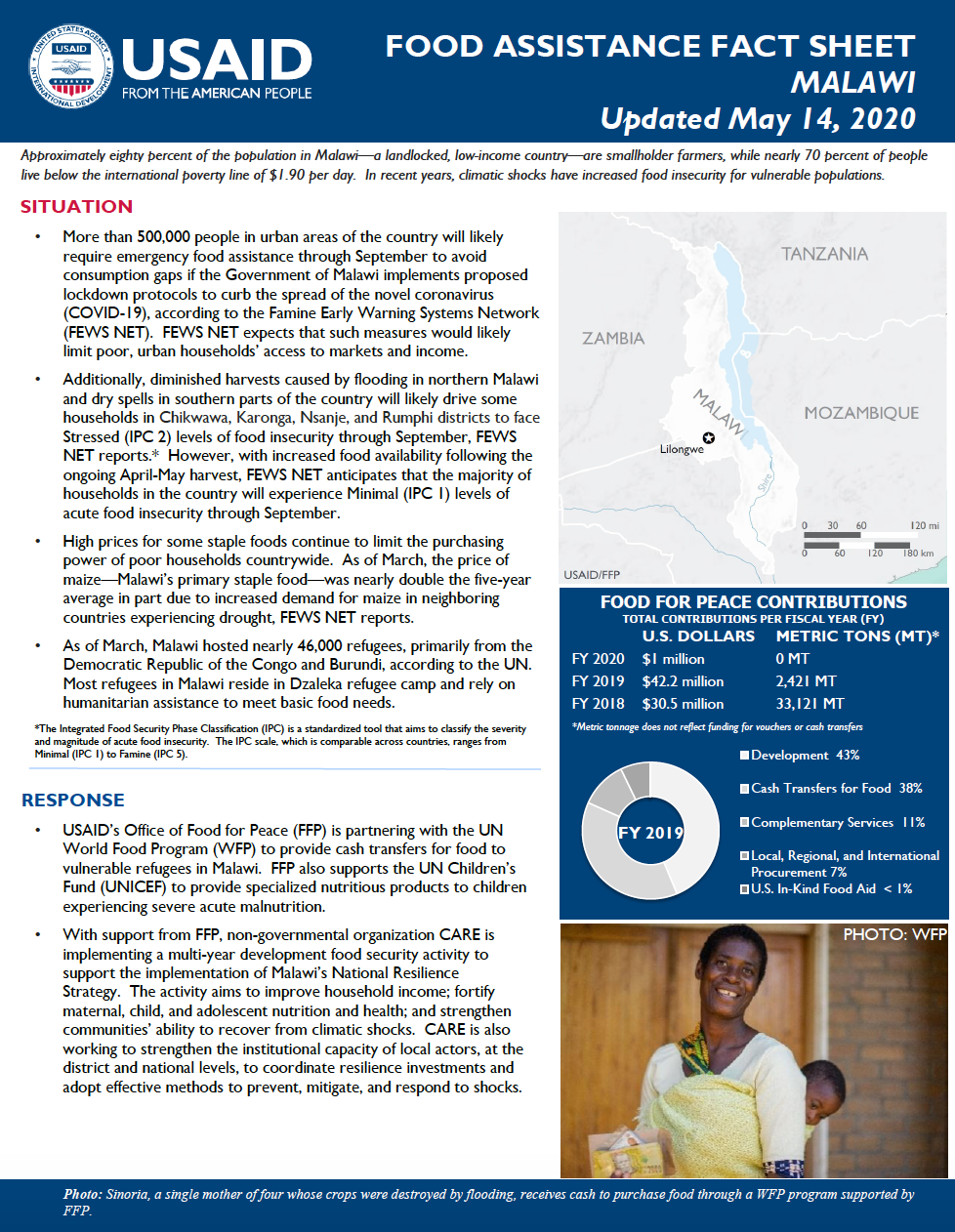Home » What We Do » Agriculture and Food Security » Food Assistance » Where We Work » Food Assistance Fact Sheet - Malawi
- What We Do
- Agriculture and Food Security
- Democracy, Human Rights and Governance
- Economic Growth and Trade
- Education
- Environment and Global Climate Change
- Gender Equality and Women's Empowerment
- Global Health
- Humanitarian Assistance
- Transformation at USAID
- Water and Sanitation
- Working in Crises and Conflict
- U.S. Global Development Lab
Speeches Shim

Map of Malawi
May 14, 2020
Approximately eighty percent of the population in Malawi—a landlocked, low-income country—are smallholder farmers, while nearly 70 percent of people live below the international poverty line of $1.90 per day. In recent years, climatic shocks have increased food insecurity for vulnerable populations.
Situation
- More than 500,000 people in urban areas of the country will likely require emergency food assistance through September to avoid consumption gaps if the Government of Malawi implements proposed lockdown protocols to curb the spread of the novel coronavirus (COVID-19), according to the Famine Early Warning Systems Network (FEWS NET). FEWS NET expects that such measures would likely limit poor, urban households’ access to markets and income.
- Additionally, diminished harvests caused by flooding in northern Malawi and dry spells in southern parts of the country will likely drive some households in Chikwawa, Karonga, Nsanje, and Rumphi districts to face Stressed (IPC 2) levels of food insecurity through September, FEWS NET reports.* However, with increased food availability following the ongoing April-May harvest, FEWS NET anticipates that the majority of households in the country will experience Minimal (IPC 1) levels of acute food insecurity through September.
- High prices for some staple foods continue to limit the purchasing power of poor households countrywide. As of March, the price of maize—Malawi’s primary staple food—was nearly double the five-year average in part due to increased demand for maize in neighboring countries experiencing drought, FEWS NET reports.
- As of March, Malawi hosted nearly 46,000 refugees, primarily from the Democratic Republic of the Congo and Burundi, according to the UN. Most refugees in Malawi reside in Dzaleka refugee camp and rely on humanitarian assistance to meet basic food needs.
*The Integrated Food Security Phase Classification (IPC) is a standardized tool that aims to classify the severity and magnitude of food insecurity. The IPC scale, which is comparable across countries, ranges from Minimal (IPC 1) to Famine (IPC 5).
Food Assistance Fact Sheet - Malawi ![]() (pdf - 309k)
(pdf - 309k)
Response
- USAID’s Office of Food for Peace (FFP) is partnering with the UN World Food Program (WFP) to provide cash transfers for food to vulnerable refugees in Malawi. FFP also supports the UN Children’s Fund (UNICEF) to provide specialized nutritious products to children experiencing severe acute malnutrition.
- With support from FFP, non-governmental organization CARE is implementing a multi-year development food security activity to support the implementation of Malawi’s National Resilience Strategy. The activity aims to improve household income; fortify maternal, child, and adolescent nutrition and health; and strengthen communities’ ability to recover from climatic shocks. CARE is also working to strengthen the institutional capacity of local actors, at the district and national levels, to coordinate resilience investments and adopt effective methods to prevent, mitigate, and respond to shocks.
- As of March, Malawi hosted nearly 46,000 refugees, primarily from the Democratic Republic of the Congo and Burundi, according to the UN. Most refugees in Malawi reside in Dzaleka refugee camp and rely on humanitarian assistance to meet basic food needs.
Food for Peace Contributions
Total Contributions:
| U.S. Dollars | Metric Tons | |
|---|---|---|
| Fiscal Year 2020 | $1 million | ---- |
| Fiscal Year 2019 | $42.2 million | 2,421 MT |
| Fiscal Year 2018 | $30.5 million | 33,121 MT |


Comment
Make a general inquiry or suggest an improvement.